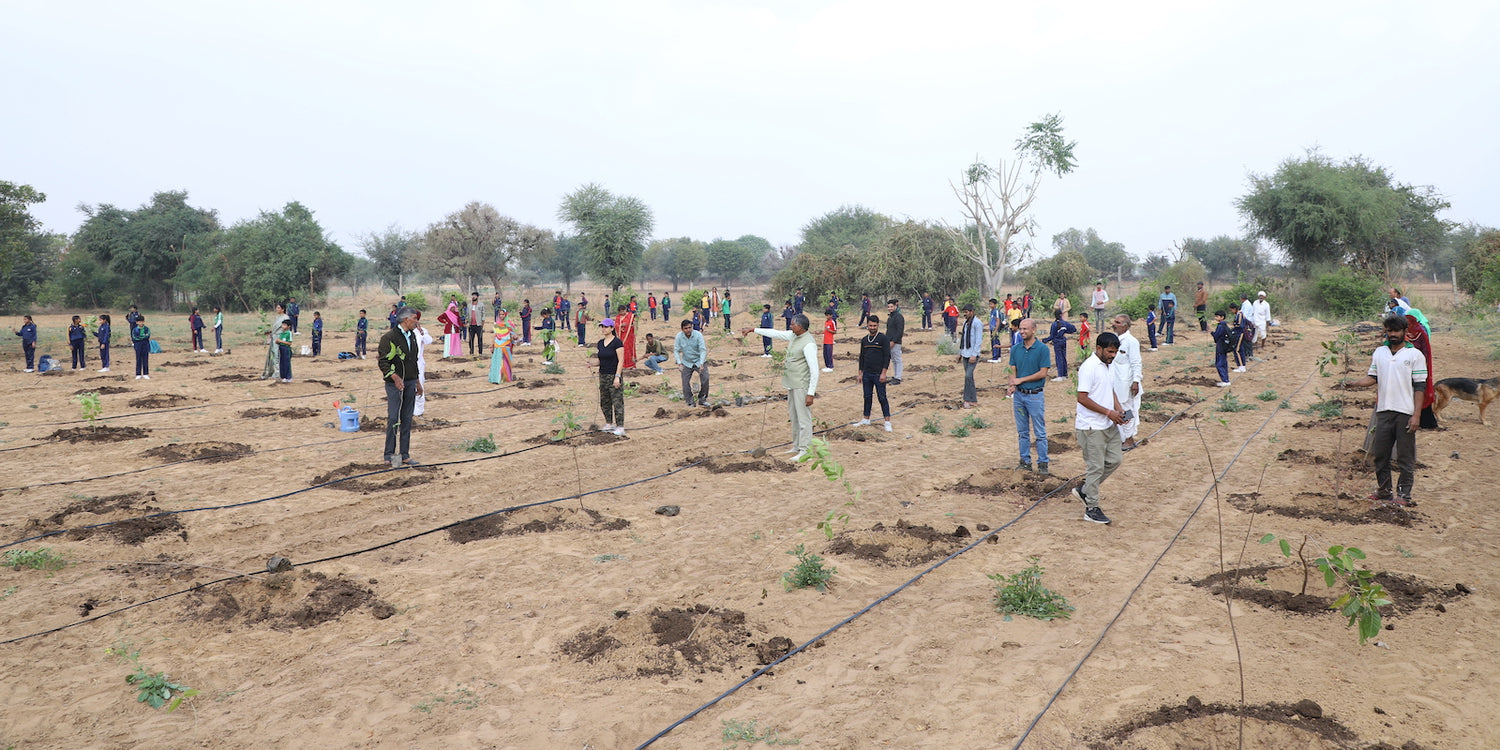Best Native Trees to grow near Ahmedabad: Urban Tree Diversity
Nestled along the banks of the Sabarmati River, Ahmedabad boasts a rich diversity of native trees that enhance its urban landscape and contribute to i Read more
Connect with us
-
👥 Corporates
If you are looking for:
- 🌲 Tree Plantation Events
- 📊 CSR Projects
📧 corporate@growbilliontrees.com
📞 +91 9699723523
💬 +91 9325931304 WhatsApp (Only)
🕒 Mon - Sat | 10am - 7pm IST
-
🧩 Tree Plantation NGOs
If you are looking for:
- 💰 Financial Assistance
- 🤝 Operational Support
📧 support@growbilliontrees.com
📞 +91 9699723523
💬 +91 9325931304 WhatsApp (Only)
🕒 Mon - Sat | 10am - 7pm IST
-
🌼 Individuals
If you are looking for:
- 👥 Group Tree Plantation Drive
- 🌳 Bulk Tree Plantation
📞 +91 9699723523
💬 +91 9325931304 WhatsApp (Only)
🕒 Mon - Sat | 10am - 7pm IST
Plantation Gallery
Trending
Trees for Corporates
Best Native Trees to grow near Ahmedabad: Urban Tree Diversity
Nestled along the banks of the Sabarmati River, Ahmedabad boasts a rich diversity of native trees that enhance its urban landscape and contribute to its ecological resilience. As the city progresses towards sustainable development, nurturing native trees becomes imperative to enrich Ahmedabad's green cover and preserve its natural heritage. Here, we explore a diverse selection of native trees ideal for growing near Ahmedabad, each offering unique benefits to urban environments.
Banyan (Ficus benghalensis): With its sprawling canopy and aerial roots, the banyan tree provides shade and sanctuary, fostering biodiversity in Ahmedabad's parks and streets.
Neem (Azadirachta indica): Revered for its medicinal properties, the neem tree's resilient nature and pest-repelling qualities make it a valuable addition to Ahmedabad's green spaces, contributing to a healthier environment.
Peepal (Ficus religiosa): Symbolizing spiritual significance, the peepal tree's heart-shaped leaves and graceful branches create tranquil havens amidst Ahmedabad's bustling streets.
Indian Rosewood (Dalbergia sissoo): prized for its sturdy timber and elegant foliage, the Indian rosewood tree stabilizes soil near water bodies and adds aesthetic value to Ahmedabad's landscapes.
Indian Laburnum (Cassia fistula): Adorned with clusters of golden-yellow flowers, the Indian laburnum tree brightens Ahmedabad's streetscapes and attracts pollinators, enhancing urban biodiversity.
Jamun (Syzygium cumini): Bearing succulent purple fruits, the jamun tree provides nutritious snacks for Ahmedabad's residents and supports local wildlife, fostering a deeper connection to nature.
Mango (Mangifera indica): Beyond its delicious fruit, the mango tree's lush foliage and shade provide relief from Ahmedabad's tropical heat, enriching the city's green cover.
Coconut (Cocos nucifera): With its iconic silhouette and versatile uses, the coconut palm graces Ahmedabad's landscapes and offers edible fruits, contributing to the city's cultural and culinary heritage.
Rain Tree (Samanea saman): Known for its expansive canopy and nitrogen-fixing capabilities, the rain tree enriches Ahmedabad's soil and provides habitat for urban wildlife.
Indian Almond (Terminalia catappa): With its glossy leaves and decorative fruits, the Indian almond tree enhances Ahmedabad's parks and gardens while offering shade and beauty to residents.
Indian Cork Tree (Millingtonia hortensis): Fragrant and ornamental, the Indian cork tree adds elegance to Ahmedabad's landscapes and provides habitat for birds and insects, contributing to urban biodiversity.
Flame-of-the-Forest (Butea monosperma): With its fiery orange blooms, the flame-of-the-forest tree adds color and vitality to Ahmedabad's streetscapes, heralding the arrival of spring.
Indian Coral Tree (Erythrina variegata): Adorned with vibrant red flowers, the Indian coral tree attracts pollinators and serves as a focal point in Ahmedabad's urban parks and gardens.
Indian Gooseberry (Phyllanthus emblica): With its tangy fruits and medicinal properties, the Indian gooseberry tree thrives in Ahmedabad's tropical climate, offering both sustenance and shade.
Indian Beech (Pongamia pinnata): Valued for its oil-rich seeds and nitrogen-fixing capabilities, the Indian beech tree supports sustainable agriculture and urban greening efforts in Ahmedabad.
Indian Laurel (Terminalia elliptica): Resilient and adaptable, the Indian laurel tree withstands urban stresses and contributes to Ahmedabad's green infrastructure, purifying the air and providing habitat for wildlife.
Cluster Fig (Ficus racemosa): With its edible figs and dense foliage, the cluster fig tree enhances Ahmedabad's biodiversity and serves as a food source for birds and mammals.
Indian Mast Tree (Polyalthia longifolia): Tall and graceful, the Indian mast tree adds vertical interest to Ahmedabad's skyline while offering shade and visual appeal to urban landscapes.
Indian Cork Fig (Ficus infectoria): With its fig-bearing branches, the Indian cork fig tree supports Ahmedabad's ecosystem by providing food for birds and bats.
Mahua (Madhuca longifolia): Cultural and ecological significance converge in the mahua tree, which produces edible flowers and supports biodiversity in Ahmedabad's urban green spaces.
Indian Sandalwood (Santalum album): prized for its fragrant wood and essential oil, the Indian sandalwood tree enriches Ahmedabad's landscapes with its aromatic presence.
Cannonball Tree (Couroupita guianensis): Unique and exotic, the cannonball tree adds intrigue to Ahmedabad's botanical gardens and parks with its spherical fruits and fragrant flowers.
Wild Almond (Sterculia foetida): With its large leaves and colorful fruits, the wild almond tree attracts birds and small mammals, contributing to Ahmedabad's urban biodiversity.
Wild Mango (Mangifera sylvatica): A wild counterpart to its cultivated cousin, the wild mango tree offers shade and sustenance to Ahmedabad's residents and wildlife.
Indian Gooseberry (Emblica ribes): Similar to Phyllanthus emblica, Emblica ribes thrives in Ahmedabad's climate, providing medicinal benefits and greenery to urban environments.
Indian Beechwood (Pongamia glabra): Fast-growing and nitrogen-fixing, Pongamia glabra supports Ahmedabad's reforestation efforts and urban greening initiatives.
Indian Coral Bean (Erythrina indica): Resilient and drought-tolerant, the Indian coral bean tree adds color and resilience to Ahmedabad's urban landscapes.
Indian Fir (Abies spectabilis): Though native to the Himalayas, the Indian fir adapts well to Ahmedabad's climate, offering evergreen foliage and a touch of mountainous charm to urban parks and gardens.
Indian Cork Oak (Quercus serrata): Durable and long-lived, the Indian cork oak tree withstands urban pressures while providing habitat for wildlife and enhancing Ahmedabad's greenery.
Indian Laurel Fig (Ficus microcarpa): Versatile and adaptable, the Indian laurel fig tree adds shade and ornamental value to Ahmedabad's urban forests and green spaces.
Growbilliontrees: In the pursuit of greening Ahmedabad's urban landscape, initiatives like Growbilliontrees play a pivotal role. By collaborating with NGOs, corporates, and other stakeholders, Growbilliontrees provides the necessary technology, knowledge, and tools to optimize, organize, and monitor tree plantation activities. Through their concerted efforts, Ahmedabad can embark on a transformative journey towards a greener, healthier, and more sustainable future.
As Ahmedabad continues to evolve, let us not forget the importance of preserving and nurturing its native trees. By embracing these botanical treasures and leveraging the expertise of organizations like Growbilliontrees, we can ensure that Ahmedabad remains a vibrant, green city for generations to come.
Best Native Trees to grow near Ahmedabad
Urban Greenery
Evergreen Trees
Evergreen trees are essential for maintaining greenery in Ahmedabad year-round. Varieties like Neem and Indian Laurel provide consistent foliage, enhancing the city's visual appeal and contributing to its ecological balance.
Fast-Growing Trees
In Ahmedabad's rapidly growing urban landscape, fast-growing trees such as Rain Tree and Indian Cork Tree are indispensable. Their quick growth rate ensures swift establishment of green spaces, improving the city's overall livability and air quality.
Drought-Tolerant Trees
Given Ahmedabad's arid climate, drought-tolerant trees like Pongamia and Peepal are crucial for sustainable urban greening. These resilient species require minimal water, reducing irrigation needs and conserving precious resources while thriving in challenging environmental conditions.
Fruit-Bearing Trees
Incorporating fruit-bearing trees like Mango and Jamun into Ahmedabad's urban environment enhances its appeal and provides fresh produce for residents. These trees attract wildlife, promoting biodiversity and offering a tangible connection to nature within the city.
Native Flowering Trees
Native flowering trees such as Cassia and Tabebuia add vibrancy to Ahmedabad's streets and parks, attracting pollinators and delighting residents with their seasonal blooms. Their presence contributes to the city's visual charm and ecological balance.
Shade Trees
Shade trees are vital for providing relief from Ahmedabad's intense heat and creating comfortable outdoor spaces. Species like Gulmohar and Ashoka offer shade and respite, improving the quality of life for residents and visitors while also enhancing the urban environment.
You may like
Corporate Plantations
FAQ
What are the best native trees to grow near Ahmedabad for urban greenery?
Ahmedabad's urban environment flourishes with native trees like the Indian Neem (Azadirachta indica), Indian Banyan (Ficus benghalensis), Indian Coral Tree (Erythrina indica), and Indian Laburnum (Cassia fistula). These indigenous species are well-adapted to Ahmedabad's climate and soil conditions, providing shade, biodiversity, and ecological resilience.
How can I ensure the successful growth of native trees in Ahmedabad's urban environment?
Successful tree growth in Ahmedabad relies on proper site selection, regular watering, appropriate fertilization, and protection from pests and diseases. Choosing native species suited to Ahmedabad's specific environmental conditions, such as hot and arid climate, is essential for their long-term health and vitality.
Are there any specific challenges in growing native trees in Ahmedabad's urban areas?
Ahmedabad's urban areas face challenges such as water scarcity, soil degradation, and urban heat island effects. However, with proper care, community involvement, and sustainable urban planning, native trees can thrive in Ahmedabad, offering numerous environmental, social, and economic benefits.
What are the benefits of planting native trees near Ahmedabad?
Planting native trees near Ahmedabad offers various benefits, including improving air quality, reducing urban heat island effects, enhancing biodiversity, and providing habitat for native fauna. Additionally, native trees contribute to soil conservation, water recharge, and climate resilience, making them invaluable assets for sustainable urban development.
How can I get involved in native tree planting initiatives in Ahmedabad?
You can participate in native tree planting initiatives in Ahmedabad by volunteering for tree planting events, supporting local environmental organizations, or contributing to initiatives like ours at GrowBillionTrees.com through donations or sponsorship. Your involvement plays a crucial role in creating a greener and more livable Ahmedabad.
What is the impact of urban greenery on the quality of life in Ahmedabad?
Urban greenery in Ahmedabad positively impacts the quality of life by reducing air pollution, mitigating heat stress, enhancing aesthetics, and promoting physical and mental well-being. Additionally, urban green spaces provide opportunities for recreation, social interaction, and biodiversity conservation, enriching the city's cultural and ecological fabric.
Are there any government regulations or guidelines for planting native trees in Ahmedabad?
Yes, there are government regulations and guidelines for planting native trees in Ahmedabad, including species selection criteria, planting techniques, and maintenance standards. Compliance with these regulations ensures the successful establishment and management of native trees in the urban landscape.
How does GrowBillionTrees.com contribute to native tree planting efforts in Ahmedabad?
GrowBillionTrees.com actively contributes to native tree planting efforts in Ahmedabad by organizing tree planting campaigns, partnering with local stakeholders, and raising awareness about the importance of native trees for urban greening. Through our initiatives, we aim to create a more resilient, sustainable, and vibrant Ahmedabad for present and future generations.























